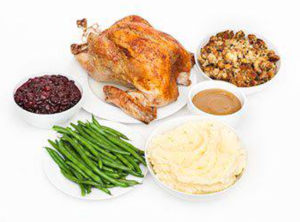Thanksgiving
Healthy and Delicious Turkey Made Easy
It is the week before Thanksgiving and I thought I’d write a bit about turkeys. I also want to let you in on a little holiday gem I’ve discovered that delivers a healthy and time-saving Thanksgiving meal!
I know you love your family and want the best for them, but is it really worth buying a fancy schmancy heirloom, free-range, sustainable, natural, organic bird?
Let’s start with “conventionally raised” turkeys. According to the Environmental Working Group, many conventionally raised turkeys are:
- Bred for abnormally large, white breast meat
- Raised in crowded conditions
- Likely treated with antibiotics while being raised
- May be injected with saline/brine, oils, flavors or preservatives at the packing plant
Let’s look at these one at a time.

First point. Why is an abnormally large breast on a turkey a problem? Americans love their white meat, and because of this, growers phased out traditional turkeys in the 1950s. Turkey growers could make more money raising the “Broad-breasted White” bird, which grows bigger and faster than the traditional bird.
Over the decades, these birds have been selectively bred and a curious problem has resulted…the breasts are now so large, that male birds (toms) are not able to mate with the females (hens) the way Mother Nature intended! The enormous male breasts actually prohibit mating. So how do these turkeys reproduce you may ask? Virtually 100% of all commercially grown turkeys are artificially inseminated. Yes, that’s correct!
It’s bad enough that turkeys can’t reproduce on their own; but the other sad truth is that these birds are not able to fly due to the large breasts.

Point two. Because commercially grown turkeys are raised in very crowded conditions and are naturally territorial, they tend to peck at each other. To minimize losses from pecking, farmers “trim” the beaks of the baby chicks with a heated blade or infrared beam. This is done without the use of an anesthetic. The American Society for the Prevention of Cruelty to Animals condemns both practices.
Point three. As you probably know, the overuse of antibiotics results in the selective breeding of “superbugs’ that are resistant to antibiotics and are a real and growing threat to all of us. The USDA allows certain antibiotics, which have growth-promoting qualities, to be given in low doses for extended periods of time in poultry feed. Before the turkeys go to market, the birds are taken off of the antibiotic feed so that no antibiotic residue remains in the tissues.
Keeping the antibiotic out of the meat does NOTHING to prevent the problem of superbugs in our environment! This is a serious threat to society in my book.
Point four. Many conventionally grown and processed turkeys are brined or injected with salts to ensure a moist bird and act as a natural preservative. I have no problem with that.
What I don’t like, are the artificial flavors and colors, and also, I don’t like the preservatives. According to the UDSA, most of the synthetic preservatives are safe in the amounts found in individual food products. However, the quantities of those preservatives add up over your lifetime and there are no long-term studies on the cumulative effects of preservatives in our food.
For an interesting graphic on decoding what turkey packaging labels mean, download the EWG’s Let’s Talk Turkey: How to decode labels to choose a better Thanksgiving bird.
My personal alternative to a conventionally raised turkey has been to opt for an organic bird.
I like this option for three reasons:
- Birds are fed vegetarian non-GMO diet (not enough research on GMOs and they are unregulated)
- No antibiotics ever (prevents antibiotic resistant bacteria)
- Granted outdoor access to fresh air, grass and bugs (humane husbandry)
Believe it or not, Whole Foods has good deals on organic birds and they are raised in humane conditions. Click here for a great video on Whole Foods practices regarding the 5-Step Animal Welfare Rating. It will make you feel good!
Now for the little gem promised earlier. Four years ago, I discovered that Whole Foods sells an entire, fully prepared Thanksgiving meal for 8, with a Diestel organic turkey and pumpkin pie, for $149.99. I did the math, and there is no way I can buy the all ingredients to feed that many mouths for the same price. Never mind that it is PREPARED for me!
I just place my order a few weeks ahead and concentrate on baking a few family favorites, like pecan fig pie and GF desserts for relatives, and pop them in the freezer. On Thanksgiving Day, I actually get to have a good conversation and enjoy my guests.
While doing the research for this post, I decided to call up Diestel Farms to find out more about their organic turkeys included in the meal. The lady was very friendly and answered all my strange questions about her turkeys.
Her answers were basically what the Whole food website says… that the birds are not fed antibiotics ever and are allowed extra time to grow so that they are more tender and juicy. I don’t know if the “tender and juicy” part is is propaganda, but that’s what she said. The turkeys in the Whole Foods organic meal are the Broad-breasted Whites mentioned above, and are indeed artificially inseminated. Knowing this, I might opt for the organic heirloom turkey next year!
Below is the Whole Foods “Traditional Holiday Menu for 8 with Organic Turkey:”
- Fully Cooked Organic Diestel Turkey (10 to 12 pounds)
- Fresh Green Beans with Shallots & Herbs (1 1/2 pounds)
- Savory Herb Stuffing (4 pounds)
- Mashed Potatoes (4 pounds)
- Turkey Gravy (1 quart)
- Classic Cranberry Sauce (1 pint)
- Dinner Rolls (12 each)
- Pumpkin Pie (even though not shown in graphic)
I hope this clarifies a few turkey purchasing facts and leads to an easy, healthy and delicious Thanksgiving meal for you.
Bon Appétit!
To listen to an audio version this post, click on the orange link below for the podcast.
Download this episode (right click and save)
This entry was posted in Food Factoids, Uncategorized and tagged antibiotics in turkey feed, beak trimming, Broad-breasted White, Holiday menu, Organic, Thanksgiving, turkey, Whole Foods.

